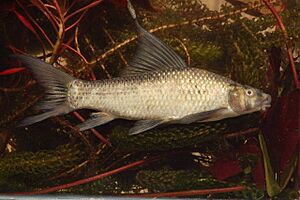Upper Zambezi labeo facts for kids
Quick facts for kids Upper Zambezi labeo |
|
|---|---|
 |
|
| Conservation status | |
| Scientific classification |
The Upper Zambezi labeo (which scientists call Labeo lunatus) is a type of fish found in southern Africa. It belongs to a group of fish called cyprinids, which includes carps and minnows.
Where It Lives
This fish lives in the Upper Zambezi River and the Okavango River. You can find it in countries like Angola, Botswana, Namibia, Zambia, and Zimbabwe.
There are usually many of these fish. But their numbers can change depending on how much the rivers flood each year.
Home and Habits
The Upper Zambezi labeo likes to live in rocky parts of streams. It also lives in big, muddy-bottomed lagoons that form when rivers flood.
This fish mostly eats algae (tiny water plants) and other small bits of food found on rocks or in the water. It prefers calm, rocky areas and usually stays away from fast-moving rapids.
You can find these fish in the main parts of rivers. They also live all over the areas that flood. These fish like to swim together in groups, which is called shoaling. They lay their eggs in the summer, probably in flooded areas near the river banks.
What It Looks Like
This fish can grow up to 40 centimeters (about 16 inches) long. The heaviest one ever recorded weighed about 2.5 kilograms (about 5.5 pounds).
Its body is greenish or silvery-grey. It has lines along its body that look like stripes. These lines come from the dark bases of its scales. Its fins also have blackish parts.
The fish has fleshy outer lips covered in small bumps called papillae. The inner edges of its lips are harder and sharper. Its back fin (dorsal fin) has four stiff spines and 9 to 11 soft rays. The fin underneath its body (anal fin) has three spines and five soft rays.
How People Interact With It
The Upper Zambezi labeo is important for local people who fish for food. They often catch these fish using traditional methods.
However, the number of these fish in the Upper Zambezi River has gone down. This is probably because too many fish are being caught, especially when they are swimming to lay their eggs. Also, special traps called fish weirs are set up in the water. These traps catch many young fish as they swim back to the rivers when the floodwaters go away.


